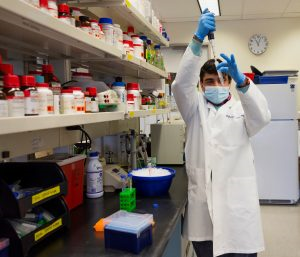As posted in UConn Today, February 11, 2021

Every year, strokes strike 800,000 Americans and are the leading cause of long-term disability in the U.S. because of the lingering brain injury they leave behind. But what if a medication used inside the brain could help heal a stroke’s damage?
Innovative stroke therapy being developed at the UConn School of Medicine aims to inhibit an important receptor implicated in ischemic stroke damage, reducing the brain damage that a stroke inflicts while also expanding the treatment window for stroke victims. It could reduce stroke size and combat stroke effects such as paralysis of one side of the body, speech and language problems, vision problems, and memory loss.
The majority of strokes are ischemic strokes, which occur when a blockage in an artery leading to the brain results in damage or death of brain cells because of reduced blood flow and oxygen supply. The damaged or dying brain cells release excessive amounts of stored adenosine triphosphate (ATP), a molecule that serves as a danger signal, leading to over-stimulation of its receptor P2X4 (P2X4R) mainly found on immune cells of the blood and brain. When P2X4R is overactive, it causes a cascade of detrimental effects in brain cells, leading to a large stroke.
A team led by Rajkumar Verma, Ph.D., assistant professor of neuroscience at the UConn School of Medicine and the Pat and Jim Calhoun Cardiology Center at UConn Health; Dr. Bruce Liang, dean of the School of Medicine and director of the Calhoun Cardiology Center; and collaborator Kenneth Jacobson, Ph.D., of the National Institutes of Health, found inhibiting P2X4R can reduce stroke damage and enhances longer term function in an animal model of stroke. Read more…